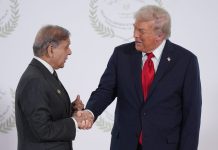Ever since the outbreak of the coronavirus, China and the US have been at each other’s throats. While China has been taking advantage of the pandemic to forward its interests in the South China Sea, Hong Kong and India, the US has resorted to passing ant-China bills and pushed anti-China rhetoric globally.
The latest manoeuvre by the US is a show of force and sends a strong message to Beijing. For the first time in 3 years, three American aircraft carriers are patrolling the Indo-Pacific waters.
The three warships are accompanied by Navy cruisers, destroyers, fighter jets and other aircraft and their presence coincide as Washington increases its pressure on China for poor handling of the coronavirus outbreak, tightening its noose on democracy in Hong Kong and resorting to bullying tactics in the South China Sea.
On Thursday, the strike group warships were spread out across the Indo-Pacific. The USS Theodore Roosevelt and its strike group are operating in the Philippine Sea near Guam, the USS Nimitz strike group is in the Pacific off the US West Coast, the USS Ronald Reagan has left port in Japan and is operating in the Philippine Sea south of there.
As reported earlier by EurAsian Times, Beijing has established administrative districts on the Paracel Islands and Spratly islands, the site of overlapping ownership claims with Vietnam and the Philippines. Additionally, Beijing has also harassed Malaysian ships and sunk a Vietnamese vessel in the region.
JF-17 vs Rafale: Why Pakistani JF-17 Thunder Poses A Serious Threat To Indian Rafale Fighter Jets?
The SCS is a key commercial sea passage connecting Asia with Europe and Africa, and its seabed is rich with natural resources such as oil and gas. A third of global shipping, or a total of US$3.37 trillion of international trade, passes through the SCS. China lay’s claim to almost 80% of the waterbody.
Bonnie Glaser, director of the China Power Project at the Centre for Strategic and International Studies believes that the presence of US in the waterbody is signal China that to not miscalculate. Chinese media was rife with speculations that because of the coronavirus, US military preparation was low.
India-China Border Clash: India Has 2 Options – Accept Losses or Counter China: US Experts
The patrol mission also brings good news for the United States Navy, which had been hit hard by the coronavirus. In March, the U.S.S. Theodore Roosevelt had pulled into Guam with a rapidly escalating number of sailors testing positive for the virus.
Over time, more than 1,000 were infected with COVID-19, setting off a lengthy and systematic process to move about 4,000 sailors ashore for quarantine and treatment.
The US national defence strategy cites China as a top security concern, and Pentagon leaders have been working to shift more resources and military assets to the region to battle Beijing’s growing economic influence and military might.
Chinese Military Base In The Indian Ocean Near Maldives To Complete ‘String Of Pearls’ Around India?
Experts at EurAsian Times believe that the arrival of US warships would be welcomed by allies in the region. Since most of them do not have the military might to combat the Chinese and are busy dealing with the virus, the US warships provide a much-needed reassurance.
The United States and China are engaged in a cold war, almost. The United States maintains that China withheld information about the coronavirus and because of its actions must be held responsible. Washington has introduced bills in the Congress targetting Chinese officials, actions in matters related to Tibet, Uighurs, and Hong Kong.
Beijing, on the other hand, has denied allegations of mismanagement and considers the other matters to be internal and has urged the US and her allies to not get involved.




